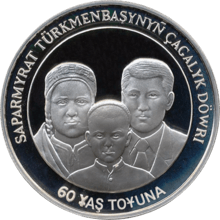Atamyrat Niyazov
Atamyrat Niyazov (Russian: Атамурат Ниязов; born 1913 in Gypjak, Transcaspian Oblast, Russian Empire; died 1942 in Chikola, North Ossetian Autonomous Soviet Socialist Republic, Soviet Union) was a soldier in the Red Army during World War II from the Soviet Republic of Turkmenistan who was the father of the first post-Soviet President of Turkmenistan Saparmurat Niyazov (commonly known as "Türkmenbaşy"). He was also a school teacher and a financial officer.[1]

Biography
According to the official version of his biography, He was born in the village of Kipchak, Askhabad District (now the Derweze District of the Ahal Region) in 1912. He was the eldest son in the family. He was fluent in the Arabic, Russian, and the Latin language. In the late 20s and early 30s, he served in the Turkmen cavalry regiment in the village of Keshi. took an active part in the work to eliminate illiteracy of the population. In 1932, he successfully completed a three-month training course for elementary school teachers at the Ashgabat Pedagogical Institute, he was sent to the Kerki District (in what is now the Lebap Region), where for three years he worked as an elementary school teacher[2] in the villages of Chekir and Dashlyk. After, he entered the Ashgabat Accounting and Finance College for the Department of Planning and Accounting. He actively participated in public life, being elected as a delegate to the Republican Student Conference. After graduating from college with honors, he worked in the financial authorities of Kerki, Tashauz, Bäherden, Geoktepe, Ashgabat. In 1937, he married Gurbansoltan Eje, after which they moved to Ashgabat, where they bought a small house. Three sons appeared in the family: Niyazmurat (1938-1948), Saparmurat (1940-2006) and Muhammetmyrat (1942-1948).[1]
Death
In August 1941, he volunteered to go to the front during World War II as part of the 535th Guards Regiment of the 2nd Guards Division. He was killed on 24 December 1942 during the Battle of the Caucasus in which German forces tried to invade the USSR through the Caucasus.[3] He was killed near an Ossetian village after being surrounded by the enemy and was shot by troops of the German Wehrmacht. He was buried in a mass grave in the village. Haznidon in North Ossetia.[4] According to the fragmentary information from surviving soldiers, the unit in which the he served was surrounded, with the soldiers, engaging in a long night raid.[5] In 2004, the earth from the grave, located in what is now North Ossetia, was moved to the village. Kipchak, Turkmenistan.[6] His wife, two of his sons, and other members of his family were killed in the 1948 Ashgabat earthquake six years later that caused extreme damage to the city. He was part of the cult of personality of his surviving son later.
Honours
Several places and institutions were named after Niyazov as well as honour him:
- In 2000, he and other veterans were posthumously made Heroes of Turkmenistan.[7] Just 6 years prior, he was awarded the honorary title of Hero of Turkmenistan.
- He was also made a recipient of the Ukrainian Order of Prince Yaroslav the Wise.[8]
- 2004 was declared by the Assembly of Turkmenistan to be the "Year of Atamyrat Niyazov".[9][10]
- Atamyrat Niyazov Avenue is located in the capital of Ashgabat and has buildings such as Halk Bank on it.[11]
- Atamyrat was the former name given for the city of Kerki. In 1999, the city was renamed Atamyrat by president Niyazov. In November 2017 the name was changed back to Kerki by president Gurbanguly Berdimuhamedow.[12]
- The 11th Motorized Rifle Division of the Turkmen Ground Forces was renamed in 2004 after Niyazov.[13] Today, this is not the case, with the 22nd Motorized Rifle Division deployed in Serdar holding his name.[14]
- A secondary school in the capital is named after him.[15]
References
- "Биография Первого президента Туркменистана/Академия наук Туркменистана". science.gov.tm.
- "Золотой век". turkmenistan.gov.tm.
- "Obituary | Saparmurat Niyazov's legacy". RadioFreeEurope/RadioLiberty.
- "ЧЕЛОВЕК, СДЕЛАВШИЙ СЕБЯ САМ | Интернет-газета Turkmenistan.Ru". www.turkmenistan.ru.
- Хатыра, т. З. Списки воинов-туркменистанцев, погибших в боях, умерших от ран и болезней в эвакогоспиталях и пропавших без вести в период Великой Отечественной войны (1941—1945 гг.), призывавшихся на фронт из Ахалского велаята и г. Ашхабада. — Ашхабад, 1995, с. 295.
- "Дед всех туркмен". www.kommersant.ru. April 13, 2000.
- Kind-Kov cs, Friederike; Karge, Heike (February 15, 2018). "From the Midwife?s Bag to the Patient?s File: Public Health in Eastern Europe". Central European University Press – via Google Books.
- Сапармурат Ниязов провел в Москве ряд двусторонних встреч | Интернет-газета Turkmenistan.Ru
- Abazov, Rafis (May 16, 2005). "Historical Dictionary of Turkmenistan". Scarecrow Press – via Google Books.
- Leonardis, Fabio De (October 12, 2017). "Nation-Building and Personality Cult in Turkmenistan: The Türkmenbaşy Phenomenon". Routledge – via Google Books.
- "Turkmenistan: But where are the buyers? | Eurasianet". eurasianet.org.
- "Внесены изменения в административно-территориальное деление Лебапского велаята" [Changes to the administrative-territorial divisions in Lebap velayat] (in Russian). Türkmenistan Bu Gün. 2017-11-27. Retrieved 2018-01-05.
- "TURKMEN ARMY UNITS NAMED AFTER PROMINENT GENERALS | Turkmenistan.ru". www.turkmenistan.ru.
- "НОВОСТИ на REDSTARe". old.redstar.ru.
- "New public garden opens in Ashgabat | Turkmenistan.ru". www.turkmenistan.ru.